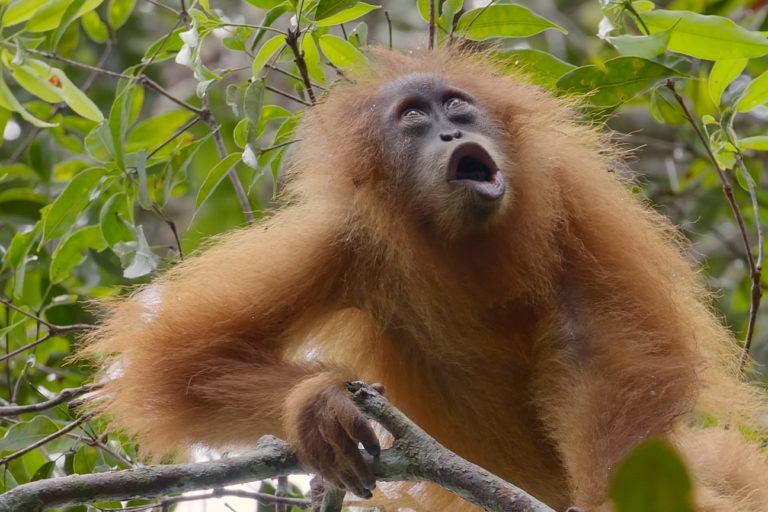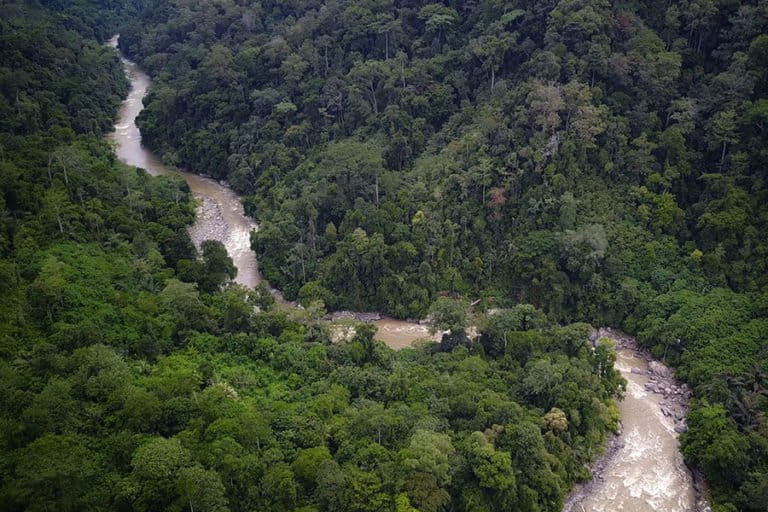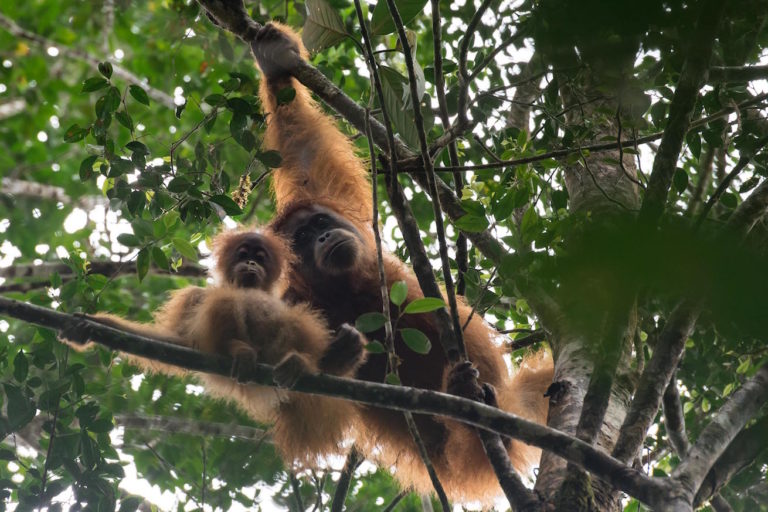- A controversial hydropower project being built in the only known habitat of the critically endangered Tapanuli orangutan has been put on hold indefinitely over the coronavirus outbreak.
- Conservationists say this is the perfect time to carry out an independent scientific assessment of the project’s impacts on the environment, and in particular on the world’s rarest and most threatened great ape species.
- But the project developer has refused to do so, claiming other developments in the Batang Toru ecosystem of northern Sumatra also pose a threat yet haven’t been asked to cease operations pending a study.
- The $1.6 billion project is also at risk of not getting the funding it needs, thanks to studies and campaigns highlighting its potentially devastating environmental impact and virtual redundancy in a region that already has sufficient electricity.
JAKARTA — Critics and supporters of a dam that threatens the only known population of Tapanuli orangutans are at loggerheads over whether to carry out an independent scientific study of the project’s impact.
Work on the hydropower plant in the Batang Toru ecosystem in Indonesia’s North Sumatra province has been put on hold since January because of the coronavirus outbreak. A tenth of the 1,200 workers at the site are Chinese, and they have not been allowed back into Indonesia after returning to their homes for the Lunar New Year holiday in late January.
With project developer PT North Sumatra Hydro Energy (NHSE) saying it doesn’t know when work will be allowed to resume, conservationists from the IUCN primate specialists’ section on great apes (SGA) have reiterated their earlier calls for an independent environmental assessment to be carried out now.
“We are willing to lead such an assessment,” Serge Wich, the co-vice chair of the SGA and a professor of primate biology at Liverpool John Moores University, told Mongabay. “It is up to the company and government to ask us and start this discussion.”
But communication has been largely one-way from the IUCN, which since last year has been calling for a halt to all projects that threaten the critically endangered Tapanuli orangutan (Pongo tapanuliensis), in particular the hydroelectric plant.
“There has been no communication about this at all as far as I know,” Wich said. He added, “I think that the company and Indonesian government would have to ask the IUCN SGA officially about an independent study. That has not happened.”

Not up to standards
The $1.6 billion hydropower project, being built by China’s Sinohydro, could devastate the most critical areas of the Batang Toru ecosystem, conservationists say.
They warn it might thwart the last chance to build forest corridors connecting the already fragmented habitats of the Tapanuli orangutan, the most recently described great ape but already the most threatened. This in turn would lead to inbreeding among the isolated groups of orangutans and the eventual extinction of the species. The species has already been hammered by road projects and loss of its habitat to farmland, with its population plummeting by 83% in just three generations. Researchers estimate there are only around 800 of the apes left on Earth.
PT NSHE denies this, saying the dam would have a minor impact on the orangutan habitat because it plans to develop only about a tenth of its 6,598-hectare (16,304-acre) concession. Emmy Hafild, a senior adviser to the company, told local media that the impact would be mitigated through various measures, such as building bridges to connect the fragmented habitats.
PT NSHE also says it has conducted environmental impact assessments under stringent standards, including the Performance Standards of the World Bank’s International Finance Corporation, or IFC-PS.
But Wich says that if this is really the case, the project would never have been built in orangutan habitat to begin with. Wich, who has carried out a spatial analysis showing forest loss due to the development of the dam and power plant, said the first step in considering such development in a great ape habitat like Batang Toru should always be avoidance. As such, he said, the first question that needs to be asked is, “Can the project be moved elsewhere?”
Wich said the IFC standard on biodiversity conservation clearly requires all great ape habitats to be classified as “critical habitat,” and thus every effort must be demonstrated to avoid developing in this habitat.
No such efforts have been demonstrated by PT NSHE, he said.

Be a shame if something happened to your work permit
The IFC standard’s guidance note also states that where great apes may potentially occur, the IUCN SGA must be consulted as early as possible to assist in the determination of the occurrence of great apes in the project’s area of influence.
“Projects in such areas will be acceptable only in exceptional circumstances,” the guidance note says. “And individuals from the IUCN/SSC PSG SGA must be involved in the development of any mitigation strategy.”
Proponents of the dam say the hydropower plant needs to be built in the area to meet the future energy needs of northern Sumatra. But a recent report from energy consultancy Brown Brothers Energy and Environment (B2E2), commissioned by various NGOs campaigning against the dam but drawing on official government data, says this region of Indonesia is already almost fully electrified, and that the new plant will do virtually nothing to improve that.
For the project to follow the IFC’s standards, the IUCN SGA has proposed an independent study to determine the implications of the project for the Tapanuli orangutan, and to see if those threats can be mitigated.
PT NSHE has established a consortium with PanEco, a Swiss-based NGO that does research on orangutans in the Batang Toru area, to carry out such a study. But Wich says this would be inappropriate, given that the consortium has a financial interest in the project’s outcome.
PanEco’s own involvement in the consortium is mired in controversy. The organization initially described the dam as “the greatest threat to the long-term future of the Tapanuli orangutan.” But it toned down its criticism after being told by Emmy that it faced having its permit to work in Indonesia terminated if its staff continued to criticize the dam. In August 2019, PanEco signed a memorandum of understanding with PT NSHE to cooperate on protecting the orangutan.
“The fact that PanEco has a MoU with PT NSHE also means that they are not an independent party anymore and therefore in our view are not suited to lead such a consortium,” Wich said.

Redesign, relocation — or cancellation
For an independent environmental impact study to be effective, Wich called for a moratorium on the project that doesn’t hinge on how long the current suspension prompted by the coronavirus outbreak lasts. He said the study may recommend changes to the project design that would reduce negative impacts on the orangutans or may even suggest it be relocated entirely or scrapped in favor of a different energy source if the impacts cannot be mitigated.
“I do not think such as assessment should be done quickly now that there is a halt due to the virus,” Wich said. “It needs to be agreed upon by all parties and there needs to be appropriate time to do this.”
For now, there are still too many uncertainties and questions that haven’t been answered regarding the potential impact of the dam on the Tapanuli orangutan, such as how the apes will react to the disturbance, he said. Construction activity for the dam has already driven some of the orangutans out of the project area and into nearby oil palm plantations.
Helen Buckland, the director of the Sumatran Orangutan Society (SOS), said all parties needed to commit to the outcomes of an independent study.
“At the heart of such studies must lie the precautionary principle, and a genuine willingness, on all sides, for the results to be incorporated going forward — whether that involves project redesign, relocation, or cancellation,” she told Changing Times. “As construction has currently halted due to the coronavirus outbreak, now seems like a perfect opportunity to set the wheels in motion for such studies to get underway.”

‘Lead by example’
PT NSHE says it will do no such thing and that it’s not the only developer posing a threat to the Batang Toru ecosystem.
“There’s a gold mine near us, there are two plantations and other kinds of economic activities,” company spokesman Firman Taufick told Mongabay.
The mine in question is the Martabe gold mine, operated since 2018 by PT Danusa Tambang Nusantara, a subsidiary of U.K. conglomerate Jardine Matheson (Jardines). Mighty Earth, a U.S.-based environmental advocacy group that has campaigned against the Batang Toru dam project, has also shone a spotlight on the environmental impact of the Martabe mine.
Mighty Earth’s great apes program director, Amanda Hurowitz, said the NGO had consistently called on Jardines not to expand further into Tapanuli oranugtan habitat, and eventually won a commitment a year ago that it would not do so.
Since then, the rate of deforestation in the western block of the Tapanuli orangutan habitat in Batang Toru has decreased, amounting to 4.7 hectares (11.5 acres) between January 2019 and February 2020, and 27.4 hectares (67.7 acres) since February 2017.
Jardines said the operations of the Martabe mine had always complied with Indonesian environmental laws and regulations.
“At the same time, the operating company of the mine recognizes the importance of conservation and acknowledges the ecological sensitivities in the surrounding area,” it said in a statement to Mongabay last year. “The mine implements a range of measures to minimize impacts on biodiversity, including strict controls on forest clearing, reporting of sightings of any threatened species, and a ban on hunting and trapping.”
Wich said PT NSHE’s insistence that the gold mine also be made to cease operations to allow an independent study of the dam’s impact was irrelevant, given the two projects’ different locations within Batang Toru.
“PT NSHE should be concerned about what they do and not redirect to other companies,” he said. “If they want to lead they can halt their operations first and ask others to follow. Lead by example, I would suggest.”
He added the site for the dam “is of special concern due to the importance for connectivity. The gold mine is also of concern but different as it is not in the area that is of direct concern for connectivity.”
Cutting off the connectivity of the Tapanuli orangutan habitat would gravely endanger the apes, according to Hurowitz.
“One of the reasons for the focus on the dam is that it would inhibit connectivity between population blocks of orangutans,” she said. “It’s hard to imagine a location for the dam that would put the survival of the Tapanuli orangutan at greater peril.”

‘We don’t want to!’
Firman said the IUCN’s focus on PT NSHE was biased, and that as an independent authority it should be “free from influences of people who have helped gold mining in Batang Toru but are opposing NSHE.”
While Firman didn’t clarify his remarks, he appeared to be referring to Wich, who in 2003 did independent work for the consultancy Hatfield Indonesia to evaluate the impact on orangutans of the Martabe gold mine, which was then being proposed.
Wich acknowledged serving as a consultant, but noted that the evaluation showed a negative impact from the mine. The concession holder at the time, PT Newmont Horas Nauli, subsequently decided not to develop the mine, and instead sold it to PT Agincourt Resources in 2016, which two years later sold it to PT Danusa Tambang Nusantara two years later.
“I do not know the details of why that decision [not to mine] was made and whether environmental concern was an issue,” Wich said. “I am not sure why [PT NSHE] state that IUCN members have helped the gold mine as that is factually not correct, for my work at least.”
Firman also questioned Wich’s argument that PanEco and other experts working with PT NSHE were not independent. Wich said that PanEco had signed an MOU with PT NSHE, which by definition means they can’t be perceived as being independent; similarly for other researchers working with the company.
“Again, if the company is so sure that they can mitigate their impact on connectivity and habitat loss, then why not let independent scientists do the work and halt the operations?” he said. “The fact that they do not do this is of concern to the conservation community and not only the IUCN.”
Emmy, the company adviser, said PT NSHE would not agree to a moratorium unless the government gave the order. She said the power plant was a priority infrastructure project under the administration of President Joko Widodo, and hence the government was the only one that could determine whether it should stop.
She also said the IUCN had ignored an invitation to attend a workshop discussing the project and its impact on the Tapanuli orangutan held by the company in February.
“They didn’t come because we’re perceived as not following their suggestions,” Emmy said. “We don’t care. They asked us to stop [the dam project] first before they would come. It can’t be like that. We don’t want to!”
In a letter to PT NSHE, Wich and a colleague at IUCN, Dirck Byler, who also serves as the director of the great apes program at Global Wildlife Conservation, explained why they declined to attend the workshop.
“Until activities related to the development of the dam are suspended, a constructive dialogue is not possible,” they wrote. “We also request that you remove the SGA from the list of participants that is being circulated as this gives a false impression participation and endorsement of the workshop.”
A total 34 “participants” were listed, but many of the named organizations, including the IUCN, declined to attend.

Jittery financiers
Wich said PT NSHE’s refusal to meet the IUCN’s recommendations for an independent study is “a clear indication that they’re not interested in mitigation. They just want to go ahead with the project and secure financing.”
Before the description of the new orangutan species was made, PT NHSE had been working to secure loans from institutions including the International Finance Corporation and the Asian Development Bank (ADB).
But following the groundswell of global concern over the future of the Tapanuli orangutan, the IFC and ADB distanced themselves from the project. And in March 2019, the Bank of China, which is also involved in financing the project, said it had “noted the concerns expressed by some environmental organizations” and would carefully review the project. It has not issued any further public updates since, leaving the funding for the project uncertain. According to Mighty Earth, however, Bank of China recently communicated that it, too, had pulled its financing for the project.
In an interview last December with Mongabay, Emmy confirmed the project’s funding was in doubt as a result of campaigns against the dam. “With the bad reputation we’ve received, I’m afraid banks are wary,” she said.
She accused groups such as Mighty Earth of focusing so much negative attention on the Batang Toru dam project that Bank of China would be forced to pull out.
“Their end game is for us to stop [getting] funding from Bank of China, so that the connection to China is severed,” she said.
Emmy said one of the reasons why PT NSHE chose Bank of China was because of flexibility.
“We Indonesians like things that are flexible,” she said.
The project’s connection to Chinese state-controlled funders and builders has also raised concerns, given their poor track record on environmental and social safeguards in projects the world over. The role of Sinohydro, in particular, has raised alarms.
Dams that it has built elsewhere have been plagued by faulty construction. In Malaysia, the company was caught on film watering down cement for the Bakun dam in the Bornean state of Sarawak. The dam also caused the inundation of 700 square kilometers (270 square miles) of forest and farmland, displacing 10,000 residents.
The Coca Codo Sinclair dam that Sinohydro built in Ecuador also had construction problems, with more than 7,000 cracks appearing within months of completion. An official report by the Ecuadoran government was critical of Sinohydro’s “irresponsible and incomprehensible” use of substandard building materials and construction methods.
Banner image: A Tapanuli orangutan in the Batang Toru forest, North Sumatra, Indonesia. Image by Matt Senior.
FEEDBACK: Use this form to send a message to the author of this post. If you want to post a public comment, you can do that at the bottom of the page.
